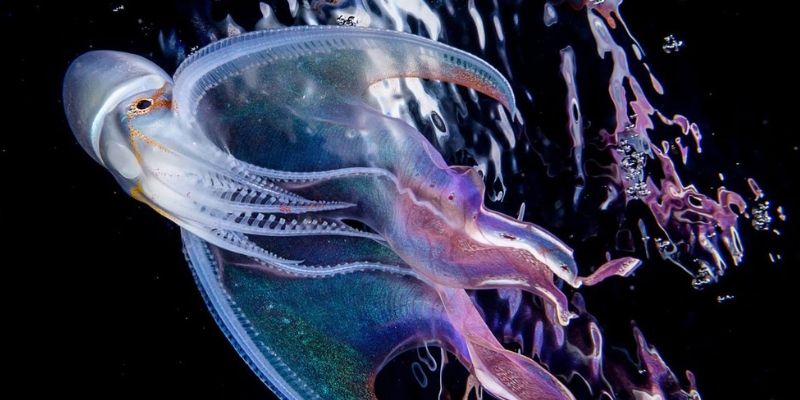
Based on the diversity of the approximately 300 species of octopus that inhabit the ocean, we know that we should never be surprised by any one species.
After all, we know that they come in a wide range of sizes. From the wolfi octopus which measures only inches in length to the giant Pacific octopus which is a true giant.
We are aware of their amazing levels of intelligence and their incredible ability to change color and even texture to blend into their environment. Octopuses can be found living in shallow water close to the shore and they can also be found in some of the deepest parts of the ocean surviving water pressures which would literally crush other creatures — such as us mortal humans. How then, could a single octopus species possibly surprise us?
Well, if you have never heard of the blanket octopus, be prepared to be surprised.
Blanket Octopus
- Scientific Name : Tremoctopus Violaceus
- Common Name: Blanket Octopus
- Size: Females: 2 m, Males: 2.4 cm
- Weight: Females: 10kg, Males: 30 gr
- Lifespan: Females: 3-5 years, Males: 1-2 years
- Found in: North and South Atlantic Oceans
- Sub-Order: Incirrina
- Discovered: 1830
- Scientific Name : Tremoctopus Violaceus
- Common Name: Blanket Octopus
- Size: Females: 2 m, Males: 2.4 cm
- Weight: Females: 10kg, Males: 30 gr
- Lifespan: Females: 3-5 years, Males: 1-2 years
- Found in: North and South Atlantic Oceans
- Sub-Order: Incirrina
- Discovered: 1830
Blanket octopuses display a sexual dimorphism when it comes to size. Females are much larger than males. We are not talking about a difference of a few inches or feet. We are talking wholesale exponential differences in size.
—What Is the Blanket Octopus?—

The popular term “blanket octopus” is the layman’s expression for identifying a particular set of octopus. Technically, this common name is given to a particular genus of octopus. This would be to the “tremoctopus” genus.
In biological taxonomy, the genus is the classification grouping that comes immediately before the species. To understand that further, think of the African lion. Its scientific name is Panthera leo. “Panthera” is the genus and Leo is the species. All big cats share the same genus. Panthera tigris is the tiger, Panthera onca is a jaguar, Panthera pardus is a leopard, etc.
With the blanket octopus, the genus consists of four species. The Tremoctopus gelatus, Tremoctopus robsoni, Tremoctopus gracilis, and the Tremoctopus violaceus.
All four species in the genus Tremoctopus share similar characteristics in terms of appearance, habitat, and behavior. However, it is the Tremoctopus violaceus species which the majority of people associate with the term “blanket octopus.” So much so, that this species, in particular, is often referred to as the “common blanket octopus.”
—Habitat of the Blanket Octopus—

As most of you are aware, the vast majority of octopuses make their home on the seafloor. Be it in shallow water or in the darkest parts of the deep ocean, octopuses like to make their home in dens which they build themselves or crevices which they appropriate for that purpose. A free and nomadic lifestyle is not the norm for most octopuses.
If you don’t take to well to surprises or shocking plot twists, we suggest that you hold on to something right now. You see, the four species that make up the blanket octopus all live a nomadic lifestyle. They rarely if ever venture to the seafloor. They do not have a den that they call home. They literally live perpetually in the open ocean.
All species of octopus, when they are hatchlings, live that type of lifestyle. They follow the currents and dwell among the nanoplankton which they hunt for food. However, all for the exception of the blanket octopus, grow out of that phase once they begin to develop body mass. By the time that other species of octopuses become adults, they have already settled down and acquired a little den of their own.
—Why Does the Blanket Octopus Seek the Open Ocean?—
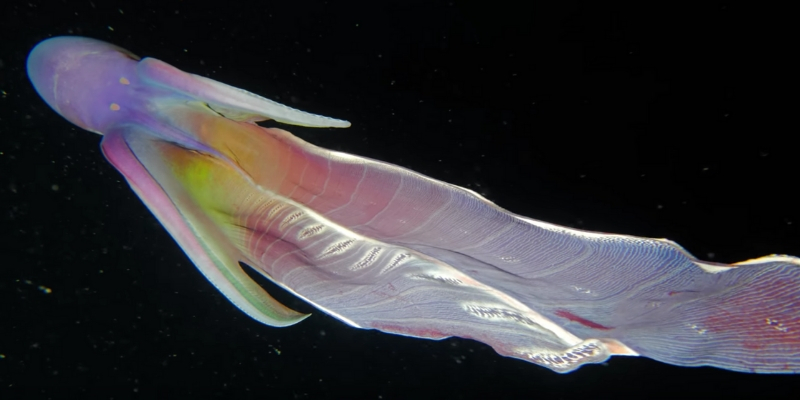
It is normal to be curious about why it is that blanket octopuses seek out the open ocean. Why don’t they settle down?
Unfortunately, the blanket octopus is one of those species which marine biologist still have a lot to learn about. In other words, even trained professionals have more questions about these species than they have answers.
One theory espouses the idea that the unique features of the blanket octopus — which will be discussed in detail the below — allowed for these creatures to adapt to the nomadic life.
Another theory goes that the unique features of the blanket octopus came about as adaptations to their nomadic lifestyle. It is the proverbial “chicken or the egg” situation. Did the blanket octopus develop its unique features due to its choice of habitat or did its habitat make it what it is today?
—Why Don't Marine Biologists Know More About the Blanket Octopus?—

Precisely because it lives in the open ocean and not on the seafloor, is what makes it too difficult for marine biologists to come across these creatures. A lot of what is known about them has come from dead specimens that have been picked up in fishing and trolling nets. Spotting an adult blanket octopus in the wild is a rare and special treat.
While examining dead specimens can reveal a lot about the anatomy of the blanket octopus, it reveals very little about its behavior and other less tangible features. This is why there are so many gaps in the knowledge of these impressive creatures.
—What Is Known About the Blanket Octopus—
Range and Distribution
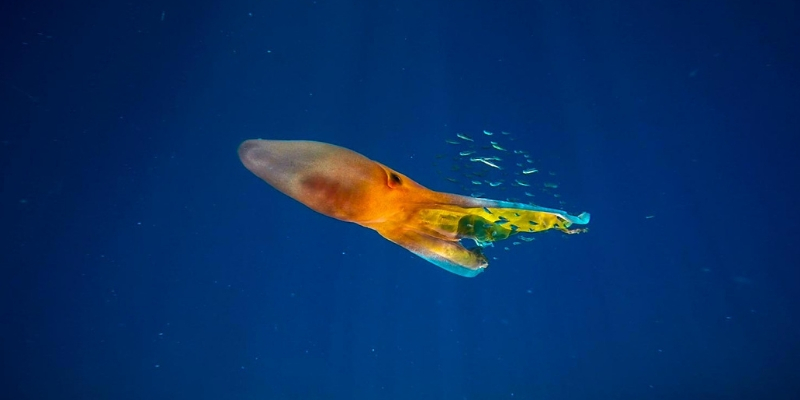
The blanket octopus can be found in tropical and subtropical waters. These include the Pacific, Indo-Pacific, and Atlantic oceans. They prefer a wide range of ocean depths — from being near the surface to moderate depths.
Since they live in the open ocean it has not been determined whether individual blankets octopuses limit themselves to inhabiting only a specific section of the ocean or if throughout their lifespan they cover thousands of miles.
Sexual Dimorphism

When talking about a specific species or group of species of octopus, normally one would talk about their size. In order to do so about the blanket octopus, it is necessary to first talk about sexual dimorphism.
Blanket octopuses display a sexual dimorphism when it comes to size. Females are much larger than males. We are not talking about a difference of a few inches or feet. We are talking wholesale exponential differences in size.
An adult female blanket octopus can reach a body length of six to seven feet. The male adult blanket octopus only reaches a length of one inch. You read that correctly, it is not a typo. The female blanket octopus is 80 to 100 times longer than the male.
If you think that the difference in body length is amazing, when you consider body weight, the female blanket octopus is 10,000 times heavier than the male.
In order to get a better perspective on the huge disparity in size between the female and male blanket octopus, imagine if human females were the size that we know them to be but human males were the size of a golf ball. Yeah, dating would definitely be a little awkward.
How Do Blanket Octopuses Mate?
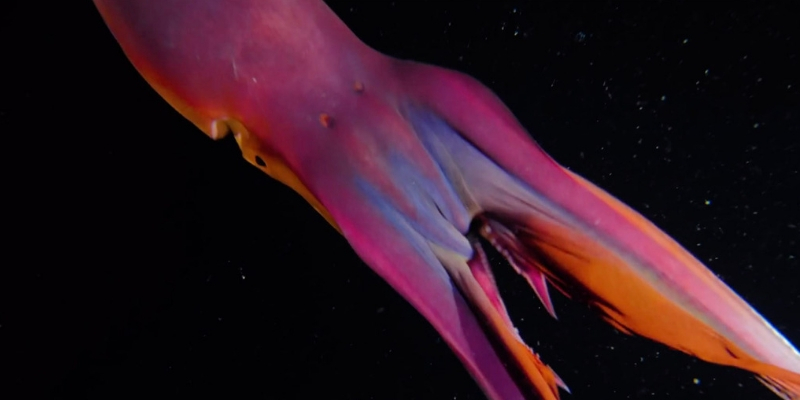
Admit it, once you were informed about the huge discrepancy in size between the male and the female blanket octopus one of the first thoughts that entered your mind was, how do they mate?
Even if you are familiar with some of the more common mating and reproductive processes of other species of octopus, when you hear how blankets octopuses do it, you will be impressed.
The male blanket octopus, like all male octopuses, has one of its eight arms as a dedicated sperm delivery appendage. This arm is formally called the hectocotylus. Informally, it is often referred to as the “sex arm.”
When a male octopus comes across a female, he will get as close as possible to her mantle and insert his hectocotylus (sex arm).
Okay, so far, so good. That’s very similar to other octopuses. But, hold on — this is where things begin to get freaky. When the male blanket octopus inserts his sex arm into the mantle of the female, it snaps off. Yes, the sex arm snaps off and begins to crawl by itself deeper into the mantle of the females carrying its little sperm packet.
The now seven armed male blanket octopus swims away and dies very shortly thereafter.
Hectocotylus autotomy, however strange it might seem, has also been observed in other pelagic octopus species such as the Argonaut Octopus.
We realize that it may take a few minutes for that image to properly sink in, but there is more.
The female carries the severed sex arm of the male in her mantle until she decides to lay her eggs. When that happens, she sprays them with the male’s severed sex arm in order to fertilize them. Female blanket octopuses will produce between 80,000 to 100,000 eggs.
If you need a moment to recover from all of this information, we understand.
How Does the Female Octopus care for Her Eggs?

Octopus mothers are considered to be among the most tender and caring for their unhatched eggs out of all invertebrates. They quite literally sacrifice everything — including their own lives — to ensure that their eggs hatch safely.
This is why nearly all species of octopus mothers lay their eggs in secured locations, such as crevices, caves, or dens. If you’re thinking that caring for her eggs causes the female blanket octopus to find a safe and cozy place on the seafloor to settle down, you are greatly mistaken.
While the female blanket octopus is caring for her eggs, she continues with her nomadic open ocean lifestyle. She remains constantly on the move just as she did before she had to take care of her eggs.
She is able to do this because she lays her eggs into a special calcerous envelope. It is cigar-shaped and she carries it with her on one of her dorsal arms. Being composed of calcium carbonate, it provides for a semi-rigid casing that keeps the eggs safe as she is free to move about. This egg envelope is made of the same substance that other mollusks use to make their shells. Think of it as a portable octopus nursery.
Soon after the eggs hatch, it is believed that the female dies. However, again, due to their open ocean lifestyle, marine biologists have not been able to confirm that as they have done with other species.
Estimated Lifespan
It is believed that female blanket octopuses may live for three to as many as five years. Males are thought to live for only 12 to 18 months.
—Defense Mechanisms—
The Blanket
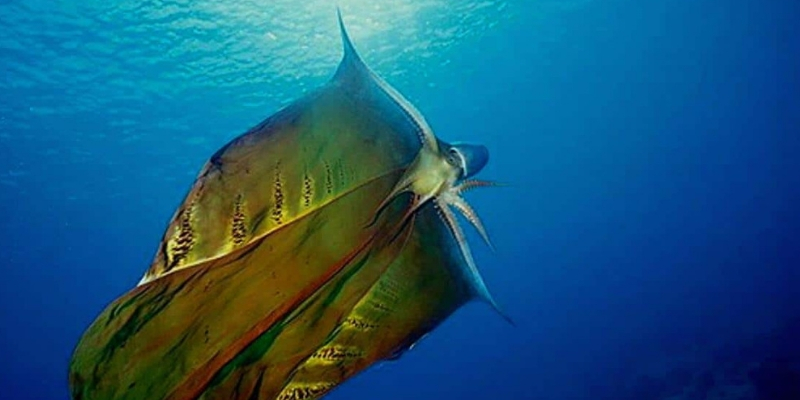
The blanket is the most iconic and obvious feature of the blanket octopus species. The blanket is not made of a cozy flannel. It consists of a web of skin that connects the two dorsal arms of the female blanket octopus.
When an adult female blanket octopus is swimming under normal circumstances, the blanket portion of her body is not really noticeable. However, if she detects a threat or the presence of a nearby predator, she will unfurl the webbing and allow it to billow in the water.
At roughly six to seven feet in length, when you add the site of the unfurled blanket, it makes the female blanket octopus appear quite large. Many times this is enough to scare away potential enemies. If not, the female blanket octopus can also shed her blanket in the hope of confusing or entangling her attacker with it.
Males, due to their miniature size, do not possess this blanket feature.
Other Defensive Features
The blanket octopus possesses the ability to change its skin color in order to camouflage itself. Even though it does not dwell on the seafloor, it has retained this attribute.
The blanket octopus also has an ink sac which allows it to release a cloud of ink in the presence of a predator.
The Ability to Make Weapons
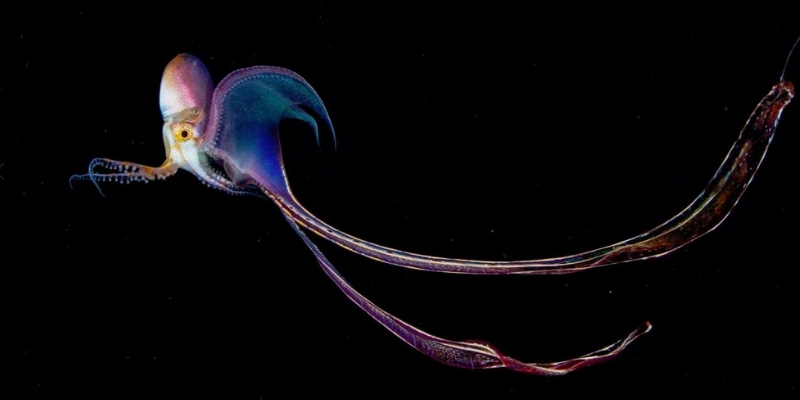
As amazing as the site of an unfurled blanket on a blanket octopus can be, it is not the most amazing thing about these species.
The majority of people who are aware of the existence of the blanket octopus are not aware of the fact that it is usually armed.
No, we are not trying to make a little game of words. The male blanket octopus, as well as the younger females, arm themselves.
They do so by ripping the tentacles off certain species of jellyfish. The blanket octopus is immune to the sting of those jellyfish so they can carry the poison-filled tentacles with their arms without any worries.
If attacked by a predator, the blanket octopus can attack the enemy with the jellyfish tentacles. Most sea creatures will recoil in pain when struck by these jellyfish tentacles.
Scientists speculate that these painful weapons are also used to capture prey.
Moreover, it is theorized that the male Blanket octopus retains its small size in order to be able to hold on to this effective defense mechanism, which is only so effective towards smaller predators. Female Blanket octopuses, on the other hand, need to be bigger to be able to carry more large eggs and increase the chances of her babies’ survival.
—Now You Know—
If you thought that the blanket was what made the blanket octopus special, now you know better. Now you are aware of all of the unique features that make this octopus so special. From its sexual dimorphism to the detachable and crawling sex arm, to the weaponized the jellyfish — it’s all amazing. Everything about the blanket octopus makes it stand out as one of the most incredible octopuses in the ocean.











